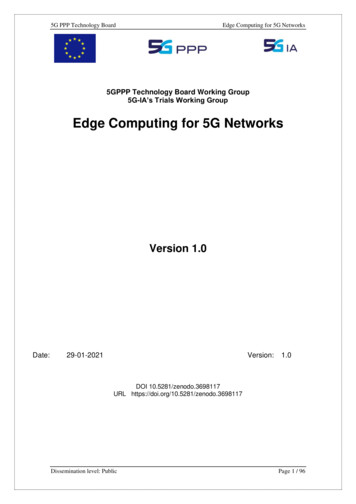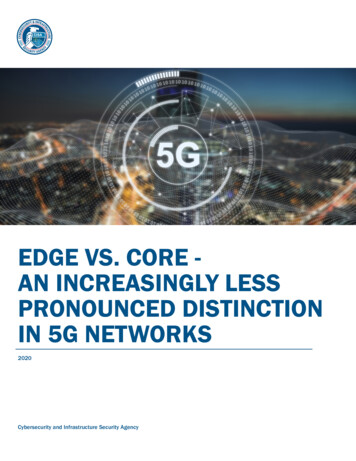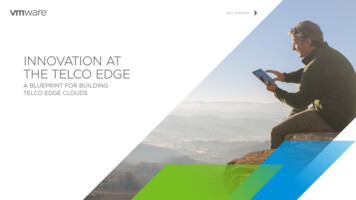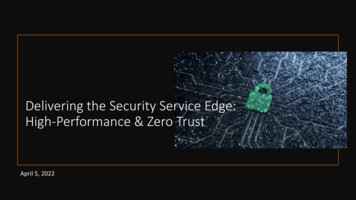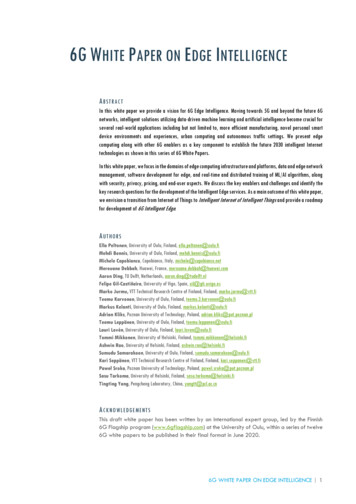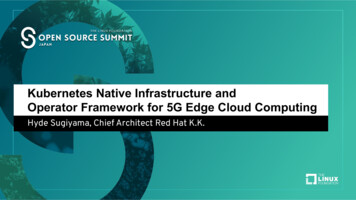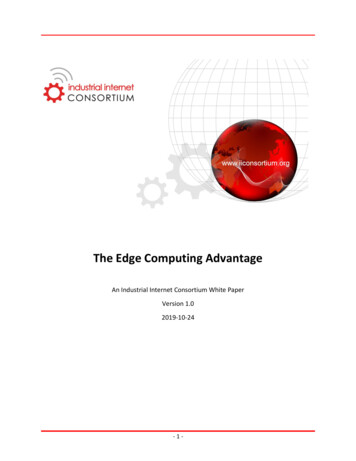
Transcription
The Edge Computing AdvantageAn Industrial Internet Consortium White PaperVersion 1.02019-10-24-1-
The Edge Computing AdvantageComputing at the edge has grown steadily over the past decade, driven by the need to extendthe technologies used in data centers to support cloud computing closer to things in the physicalworld. This is a key factor in accelerating the development of the internet of things (IoT). But, asis often the case with new technology, there is an abundance of overlapping terminology thatobfuscates what the fundamentals are and how they relate to one another. We aim here todemystify edge computing, discuss its benefits, explain how it works, how it is realized and thefuture opportunities and challenges it presents.BUSINESS BENEFITS OF EDGE COMPUTINGCloud computing in data centers offers flexibility and scale to enterprises. We can extend thosebenefits towards “things” in the real world, towards the edge. We accrue business benefits byconnecting things and isolated systems to the internet, but there are risks that should bebalanced against them. Disciplined security of the whole system is needed to make it trustworthy.The flexibility to decide where to perform computation on data improves performance andreduces costs. Sensors are generally limited in terms of what they can do, while computing indata centers induces bandwidth costs as data is transmitted to them. Computing in the edgeenables collecting data from multiple sources, fusing and abstracting it as needed, and computingon it right there. For example, the data from a surveillance camera can be abstracted intogeometric features and eventually a face. If there is an issue requiring immediate action(detection of a known criminal, for instance), it can be acted on then and thereby reporting thelocation to the police or denying them access through a turnstile. Other information can beanalyzed later.Similarly, the flexibility to decide where to store data improves performance and reduces costs.Moving data uses potentially scarce bandwidth, costs money and increases the attack surface.Computing in the edge can segment data based on compliance boundaries imposed by regulationin different jurisdictions. Data segmentation also supports disciplined security and connectivityto the internet. If data is held on the premises with no connection to the internet, it less likely tobe compromised by the proverbial hacker in his parents’ basement.Many industrial facilities are relatively secure today because they are not connected to theinternet. In the jargon, there is an airgap between the facility and the internet. Once that airgapis breached, the facility is prone to many threats and risks hitherto unconsidered. There are manyways to cross airgaps (breaking down the doors, for example), but that requires physical access.Once connected to the internet, hackers worldwide can gain control of actuators andcompromise safety.Deployment flexibility also enables separating tasks that should be executed quickly from thosethat need more time. For example, training a machine-learning model may be executed in the-2-
The Edge Computing Advantagedata center, while the real-time inference phase of the algorithm to score the model for specificobservations can be deployed in the edge “near” the device it controls.Similarly, executing close to where the data is generated in the physical world, rather thanpassing data up to a data center and back down, reduces the time lag (latency) and indeterminatevariation (jitter) between receiving data and acting on it. Faster is usually better, but determinismis essential for optimizing time-critical industrial processes. Critical control processes thatexperience too much latency or jitter can become dangerously unstable.Localization of data and computation can improve privacy, security, reliability, resilience andsafety, which, taken together, comprise trustworthiness. Keeping data local keeps it privatewithin different security boundaries as defined by the particular application.Computing in the edge using redundant, fault-tolerant systems enables critical services tocontinue in mission- and life-critical applications even as nodes or links fail. When connectivity toa data center or adequate computational throughput is unavailable, tasks can be emulated in theedge, or queued until connectivity is restored.Computing in the edge enables new applications and features, which can increase efficiency,revenue and value for the customer. For example, smart grids are already feeding distributedenergy resources into the power network, reducing energy costs and even providing discountsto customers.Computing in the edge is fundamental to distributed applications such as connected cars. A caris already a network on wheels. Edge computing enables a platoon of cars traveling at high speedto communicate, making split-second decisions to avoid accidents and to travel closely togetherto save road space.With these benefits in mind, we can now examine edge computing.WHAT IS EDGE COMPUTING?There is a plethora of words that have been used to describe edge computing and thetechnologies around it. Among them: edge, fog, edge computing, fog computing, mist, cloudlets,thing-to-cloud continuum and fog-to-cloud continuum. These names take certain perspectivesand apply to specific technologies that will undoubtedly change. Here we capture edgecomputing as a set of core capabilities, and strictly limit the vocabulary used to describe them.We intend the term “edge computing” to embrace all of these perspectives.The computing model is fully distributed and can support a wide range of interactions andcommunication paradigms. Edge computing lies between physical things in the real world asmonitored and controlled by IoT devices (sensors and actuators), via layers of edge nodes to thedata center. Operational technology production, supervision, and safety control can beimplemented in edge nodes. This architecture also enables communication across subsystems.-3-
The Edge Computing AdvantageTo be able to support many vendors, legacy equipment and protocols, as well as avoid vendorlock-in, we need to be able to assemble hardware and software from multiple providers into asystem that will interoperate seamlessly. In legacy systems, this may include multiple controllersusing multiple protocols and gateways from different vendors, all of which need to be connected.The topology of the network enables IoT systems to make use of layers of edge nodes andgateways to interconnect IoT devices and connected subsystems with various types of datacenters. The cloud is the “highest-order” resource, and is usually implemented in large, protecteddata centers. It may be public, private or a hybrid to process and store data for specific verticalapplications. Edge nodes perform local processing and storage operations.Edge nodes can work alongside traditional IoT network elements such as routers, gateways andfirewalls, or subsume those functions into a merged device that has computation and storage-4-
The Edge Computing Advantagecapabilities. North-south data communication links connect between layers, while east-westcommunication interconnects nodes on similar layers. Some of the nodes are public and shared,while others are private; some a combination. Processing and storage functions operate atwhichever node and layer most efficiently meets the applications' requirements, which is howwe reduce costs. Taken together, edge computing comprises: computation and storage resources, with layers of edge nodes between the data centerand things in the physical world,peer-to-peer networking, such as security cameras communicating about objects withintheir scope, a platoon of connected vehicles or a fleet of wind turbines,distributed computation across IoT devices, edge nodes and the data center,distributed data storage for preserving data in IoT devices, edge nodes and the datacenter anddistributed security functions, like data segmentation, authentication and encryption.With edge computing, data, storage and computing are distributed throughout layers of edgenodes from IoT devices to the data center, distributing the economies of scale of the cloudthroughout the IoT system.To respond to new applications or varying workloads, we need to be able to add or removeresources quickly by reconfiguring the system to execute on more or fewer edge nodes. Thiselasticity supports, for example, first responder teams when computation and connectivity needsfluctuate in an emergency. It also enables scale so that small customers with modest needs canexist alongside web-scale operators with millions of users and provide this service at lower cost.To be able to support many configurations, we need to be able to allow multiple independententities to share the common infrastructure without interfering with each other or causingsecurity and privacy problems. This is called multitenancy. Without this, a smart city, for example,would have to build out parallel networks and edge nodes for every government agency, logisticscompany, transportation carrier, mobile operator or smart grid in the city. That would be costprohibitive and clutter every street corner.HOW IS EDGE COMPUTING REALIZED?Rarely does any digitalization initiative start from scratch; there are existing computation andstorage resources that need to be integrated and that means we need interoperability.Interoperable edge computing is realized by agreeing on architectural and protocol standards,and by separating the logical (what the user perceives) from the physical (the actual computingmachinery) to allow a single resource to be shared between several users. This is calledvirtualization, and it helps cuts overall costs for all users, because they need not buy that resourcefor themselves. It also enables scaling so that when one resource is inadequate, more can beadded seamlessly, improving performance.-5-
The Edge Computing AdvantageIn addition to sharing physical resources, this integration enables a single software application toserve multiple customers, where you share the same application software with your own privatedataset. This is called software multitenancy.Multitenancy is also used for sharing the resources in the network that supports the edge. Itsowner (the landlord) allows multiple independent entities (tenants such as companies, agenciesor individual users) to share the common infrastructure without interfering with each other orcausing security or privacy problems.Managing the diversity found in deployments of edge nodes, virtualization and multitenancy is agargantuan task, especially when resource availability and demand change rapidly. It cannotpossibly be done manually. Automatic configuration, coordination and management of theelements comprising the edge is a must. This is called orchestration, which takes placethroughout the lifetime of the system to include initial configuration, run-time resourceallocation, fault recovery and managing abnormal situations such as a denial of service attack.Taken together, integration, virtualization, multitenancy and orchestration providemanageability to ensure efficient configuration and operation of resources in the edge andenable edge-computing users to scale elastically. We need to be able to change system structureas the volumes and requirements change. Edge computing enables distribution of computationworkloads to any part of the infrastructure: control systems, sensors and actuators, the datacenter, and anywhere in-between. This enables distributed data management for both data atrest and data in motion, defining where and what data is to be stored, in what form, and for howlong. Edge computing supports diverse data governance models, including quality, discovery,segmentation, usability, privacy and security.That last is key. When you connect edge nodes or IoT devices to the internet, you must securethem. We know how to make IoT devices secure and what needs to be done, but not all devicesare secure. An IoT device may have been built without security in mind, or be a part of a legacysystem. Devices are being hacked every day and the problem will only worsen. Moreover, edgedevices may be deployed in unsupervised and remote locations prone to attacks ranging fromphysical tampering to modifications of the code. Current security mechanisms cannot scale tothe rapid growth of the IoT. Many IoT devices don’t have the computing power or energyreserves to perform strong security processing on their own. Edge computing can extend securityimprovements to edge nodes and allow the management of complex security policies on behalfof less capable IoT devices.We have to know what every connected IoT device is, and we have to know it is correctlyconfigured by properly authorized staff using authenticated code and data. What you don’t knowcan hurt you. Once authenticated, we can trust the data coming from them. Without that, an IoTdevice could send false data, and with false data you cannot trust any part of your system, fromhow you act on that data to training algorithms for machine control. Edge computing enables-6-
The Edge Computing Advantagedisciplined security at all levels of an IoT solution from sensors and actuators to the data center,and this creates trustworthiness.OPPORTUNITIESThe edge computing model provides opportunities, and there are some trends in the industrythat are likely to continue to influence it.In the future, it will be less expensive to create significant business and social value. Asbottlenecks are discovered, fixes will be applied. In the 1960s and 1970s, memory was slow andcomputing power relatively faster. That drove the industry to improve access to memory andthen the obverse was true. This cycle will continue. There will be pressure on networkmanagement costs, necessitating edge manageability improvements and ceaseless pressure ontotal lifecycle cost of ownership from purchase price, to installation, management, energy usage,updates and decommissioning. Techniques currently in the news, such as artificial intelligence,were known decades ago but there was neither enough computing power nor data capacity toenable those techniques to be applied in reasonable time.We expect these pressures to continue to move computation and data around. Computationswill be executed in the “best” location; data will be stored where it can be accessed mostefficiently. Computation will be drawn towards the data (data gravity) at the optimal location forit. And that will continue too. This suggests needs for architectural standards and innovation inscaling, depending on the specific application. Some edge nodes will scale down, running oninexpensive, low-power, compact hobbyist-class computers; others will scale up, running oncomputer clusters with equivalent power to hundreds of rack-mounted servers, depending onwhere the data pulls them.The centers of data gravity depend to some degree on required response times—how quickly thedata needs to be acted upon. For example, training a machine-learning model requires a gooddeal of data and time. This can be done in the data center, and the trained model deployed closerto the IoT devices, possibly in the physical plant that needs to be controlled and optimized. Thisreduces latency and improves user response. Consequently, we expect to see artificialintelligence, machine learning and deep learning to become more widespread and provide newinsights and intelligence to optimize decision-making.Data gravity also applies to services as they migrate closer to where they need to be, or furtheraway for broader data spans. This will enable new business models and new services.Entities need to share information; they also need to keep it private. Distributed ledgertechnologies, such as blockchain, can be used as authentication providers. This means that moredata can be shared because the provider has more confidence that the shared data will berestricted to the preselected groups. This could be used to provide attestation of edge elementsand software, and track the provenance and completeness of the critical edge-hosted data.-7-
The Edge Computing AdvantageReliability can be improved by adding redundant edge nodes, but this increases costs. Dependingon the application, different patterns will emerge for certain types of applications, taking fulladvantages of edge computing architectures and cutting costs.CHALLENGESThere are always challenges, many of which we have mentioned above. But there are more.When the internet of things first appeared on the hype curve, there were ever-increasingestimates of the number of IoT devices that could be connected to the internet (and everincreasing time scales). We face several scaling challenges to realize the potential for IoT. First,enormous numbers of devices, and the connections between them, increase complexity.Provisioning edge nodes between the IoT devices and the cloud can reduce it. Second, clustersof edge nodes, as in data centers, require large amounts of energy and cooling. Consequently,some data centers are located near hydro-electric power generation in cooler climes. But howcan the energy consumption issue be addressed when the edge nodes need to be close to theIoT devices?Conversely, when IoT devices (and their associated edge nodes) need to be physically located inremote, environmentally challenging places, how can they be maintained, provisioned andsecured? For example, an oil field in a remote desert location in a politically unstable country willneed reliable power (generators from well by-products?), cooling, physical security and aninternet connection. How are we to do that? More generally, how are we to address newapplications of the technology in various environments?Demand management is a challenge. When a natural disaster occurs in a smart city, for example,the demand curve shifts dramatically owing to a huge number of IoT devices reporting changesin data. Moreover, when infrastructure is damaged, regardless of the location, we need to standup new infrastructure rapidly. How are such changes in demand to be handled?Disconnection is an issue. Because a connection cannot be guaranteed all the way from IoTdevices to the data center all the time, we need to store information and execute critical controlalgorithms locally until the connection is available again. This requires more processing powerand storage and that affects scalability. This also implies that you can’t just take legacy hardware,without such processing capability or storage, and make it work in edge computing scenarioswithout some newly deployed hardware.Complexity also bedevils software, especially as we move data between verticals. Each verticaltends to develop its own application interfaces and standards, each exposing different features.Moreover, significant domain knowledge is needed to integrate different domains. An engineerconversant with oil and gas, for example, may know nothing about energy generated from dieseland solar to supply the edge nodes at the oil wells. To facilitate software development, commonplatform infrastructures and standardized application programming interfaces are needed. We-8-
The Edge Computing Advantagealso need to abstract data further and find ways to converse between different data abstractionmodels. Semantic interoperability is a general name for techniques that address this challenge.How can we develop generalized patterns that can be applied in many verticals?Skilled technical experts for edge computing and its applications are needed. That meansrelationships with academics and universities to develop training materials and certifications forindividuals. How else will we find people who can train the next generation?The Industrial Internet Consortium’s mission is to accelerate the development of the internet ofthings. This paper addressed a key challenge we have encountered: market confusion. We havegroups of member representatives working on defining edge computing (of which this paper isjust a part) and innovating to address the challenges outlined above. By reducing confusion,especially over terminology, we help to develop the marketplace and achieve our mission.WHAT DOES THIS ALL MEAN?There are many evident technical and business advantages that drive edge computing to becomea keystone of IoT's evolution. In response to the high-compute, high-performance and lowlatency requirements of IoT, edge computing moves critical data, storage and network functions“closer” to the things, co-located in the IoT device or physical plant. When properly designed andadministered, this enables otherwise unattainable performance, efficiency, reduced operationalcosts and opens opportunities for new IoT applications.Edge computing provides many of the qualities that will be required in IoT settings in the comingyears. Edge computing is inherently scalable and elastic—it flexibly supports multiplecommunications models, layers and software programmability features. Edge computing securitysupports trustworthiness of the entire IoT solution from sensors and actuators to the cloud.We will continue to see blurred lines from the edge to the data center, as cloud-computing andedge-computing architectural models merge and emerge. Here we have striven to demystifythese technologies, identify some benefits, define edge computing and how it is realized, andthen look ahead at future opportunities.For these reasons, we believe edge computing will have a profound effect on the future of IoT.That’s what this means. We are only at the beginning of a multi-decadal revolution.-9-
The Edge Computing AdvantageNEXT STEPSThere is a lot to learn. To get started, here are somereferences you can check out: Introduction to Edge Computing,Industrial Internet Reference Architecture,Industrial Internet Security Framework,Industrial Internet Connectivity Framework,Industrial IoT Analytics Framework,OpenFog Reference Architecture and theIndustrial Internet Vocabulary.Note that these documents are also located at ourglobal Resource Hub, where you can find many otherpieces of information.IIC members gain experience they couldnever have as a non-member. Theyexperience member meetings unlike anylocal meet-up groups. Here are some keybenefits of membership: You can also work with us to learn more and addressthis exciting challenge. Please join us.The Industrial Internet Consortium is the world’s leadingorganization transforming business and society byaccelerating the Industrial Internet of Things. Our mission isto deliver a trustworthy Industrial Internet of Things inwhich the world’s systems and devices are securelyconnected and controlled to deliver transformationaloutcomes. Founded March 2014, the Industrial InternetConsortium catalyzes and coordinates the priorities andenabling technologies of the Industrial Internet. TheIndustrial Internet Consortium is a program of the ObjectManagement Group (OMG ).Visit www.iiconsortium.org.- 10 - Networking: Make the connections;find the needed expertise.Information & News: A fast pass tonewsworthy industry developments.Competitive edge: Stay ahead of thecompetition or take advantage ofchanges and developments that mightotherwise have passed you by.Create a market: Join a collectivevoice supporting a single mission;create the disruption in the marketand develop the businessopportunities.Success: Members are buildingbusinesses and dedicating theirprofessional lives to IIoT. They want tobe successful, and they want others tosucceed.Professional development: Grow yourcareer, meet mentors and mentees,career prospects.Solve important problems and helpyour partners and customers.Events: Capitalize on opportunities forcontinuous exposure to industrydevelopments.
The Edge Computing AdvantageAUTHORS AND LEGAL NOTICEThis document is a work product of the Marketing Working Group.Authors: The following persons contributed substantial written content to this document: ChuckByers (IIC staff), Ron Zahavi (Microsoft), John K. Zao (National Chiao Tung University).Contributors: The following persons contributed valuable ideas and feedback that significantlyimproved the content and quality of this document: Evan Birkhead (IIC staff), K. Eric Harper (ABB),Brett Murphy (RTI), Mitch Tseng (Tseng Infoserv).Technical Editor: Stephen Mellor (IIC staff) oversaw the process of organizing the contributionsof the above Authors and Contributors into an integrated document.Copyright 2019 Industrial Internet Consortium, a program of Object Management Group, Inc.(“OMG”).All copying, distribution and use are subject to the limited License, Permission, Disclaimer andother terms stated in the Industrial Internet Consortium Use of Information – Terms, Conditions& Notices, as posted at http://www.iiconsortium.org/legal/index.htm#use info. If you do notaccept these Terms, you are not permitted to use the document.- 11 -
demystify edge computing, discuss its benefits, explain how it works, how it is realized and the future opportunities and challenges it presents. BUSINESS BENEFITS OF EDGE COMPUTING Cloud computing in data centers offers flexibility and scale to enterprises. We can extend those benefits towards "things" in the real world, towards the edge.




